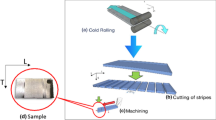Abstract
Repetitively prototyping several prototypes of the same component using currently available rapid-prototyping equipment can be very costly. Substantial savings can be attained with the use of a metal spray process to produce a crust shell on a rapid-prototyping pattern coated with mould release agent (PVA), and then backing the crust with aluminium granules so as to form rapid mould/tooling (RT). The smoothness of the innermost spray layer and its dimensional accuracy in relation to the RP prototype are factors that ensure good quality of parts replicated by RT. This paper establishes a preliminary model for predicting the upper bound of the former and the lower bound of the latter, which have been experimentally verified by arc spraying zinc onto PVA. The theoretical model permits the prediction of spraying parameters for controlling the achievable surface finishing and dimensional accuracy of a spray in RT production.









Similar content being viewed by others
Reference
Bennett G (1995) First National Conference on Rapid Prototyping and Tooling Research. Mechanical Engineering Publication, London
Weiss LE, Thuel DG, Schultz L, Prinz RB (1994) Arc-sprayed steel-faced tooling. J Therm Spray Technol 3(3):275–281
Bennett G (1997) Second national conference on rapid prototyping and tooling. Mechanical Engineering Publication, Bury St. Edmunds, UK
Finch CA (1992) Polyvinyl alcohol-developments. Wiley, New York
Finch CA (1973) Polyvinyl alcohol-properties and applications. Wiley, New York
Hui IK, Hua M, Lau HCW (2003) A parametric investigation of arc spraying process for rapid mould making. Int J Adv Manuf Technol 22:786–795
Lavernia EJ, Wu Y (1996) Spray atomization and deposition. John Willey and Sons, Chichester
Geiger GH, Poirer DR (1973) Transport phenomena in metallurgy. Addison-Wesley, Reading, p 68
Kovaceivic R, Mohan R, Murugesan M, Seybert AF (1995) On-line monitoring of the electric arc-spraying process based on acoustic signatures. Proceedings of the Institution of Mechanical Engineers, Part B. J Engin Manuf 209(B5):369–379
Marantz DR, Marantz DR (1990) State of the art arc spray technology. Thermal Spray Research and Application, Proceeding of the Third National Thermal Spray Conference, pp 113–117
Matijevic E (1969) Surface and colloid science, vol 2. Plenum Press, New York, pp 45–87
Newbary AP, Cantor BRM, Jordon RM, Singer ARE (1992) Arc spray forming of nickel aluminides. Cripta Metallurgica Materialia 27:915–end
Steffens HD, Babiak Z, Wewel M (1990) Recent development in arc spraying. IEEE Transaction on Plasma Science 18(6):974–979
Sobolev VV, Guilemany JM (1998) Effect of substrate deformation on droplet flattening in thermal spraying. Materials Lett 35:324–328
Sobolev VV, Guilemany JM (1998) Influence of droplet impact angle on droplet-substrate mechanical interaction in thermal spraying. Material Lett 33:315–319
Trapaga G, Szekely J (1991) Mathematical modeling of the isothermal impingement of liquid droplets in spraying processes. Metallurg Trans B 22B:901–914
Fukai J, Zhao Z, Poulikakos D, Megaridis CM, Miyatake O (1993) Modeling of the deformation of a liquid droplet impinging upon a flat surface. Phys Fluids A 5:2588–2599
Liu H, Lavernia EJ, Rangel RH (1993) Numerical simulation of substrate impact and freezing of droplets in plasma spray process. J Phys D: Applied Physics 26:1900–1908
Pasadideh-Fard M, Lostaghimi J (1996) On the spreading and solidification of molten particles in a plasma spray process: effect of thermal contact resistance. Plasma Chem Plasma Process 16:83S–98S
LeFebvre AH (1989) Atomization and sprays. Hemisphere (Taylor and Francis Group), New York
Lugscheider E, Barimani C, Eckert P, Eritt U (1996) Modeling of the APS spray process. Comput Mater Sci 7(1–2):109–114
Daugherty RL, Franzini JB, Finnemore EJ (1985) Fluid mechanics with engineering applications, 8th edn. McGraw Hill, New York
Lau CC (2001) Preliminary development of automated rapid tooling process by metal arc spraying Incorporated with STL file—investigation of surface roughness and dimensional accuracy of spray. MPhil Thesis, City University of Hong Kong
Lide DR (2001) CRC Handbook of chemistry and physics, 82nd edn. CRC press, Boca Raton
Barton AFM (1991) CRC Handbook of solubility parameters and other cohesion parameters, 2nd edn. CRC press, Boca Raton
Acknowledgement
This project is partially supported by the City University of Hong Kong, Project No. 7001202.
Author information
Authors and Affiliations
Corresponding author
Rights and permissions
About this article
Cite this article
Hua, M., Lau, C.C., Hui, I.K. et al. Limit analysis on surface roughness and dimensional accuracy of spray metallic crust for rapid tooling production by metal arc spraying process. Int J Adv Manuf Technol 23, 720–731 (2004). https://doi.org/10.1007/s00170-003-1712-0
Received:
Accepted:
Published:
Issue Date:
DOI: https://doi.org/10.1007/s00170-003-1712-0




